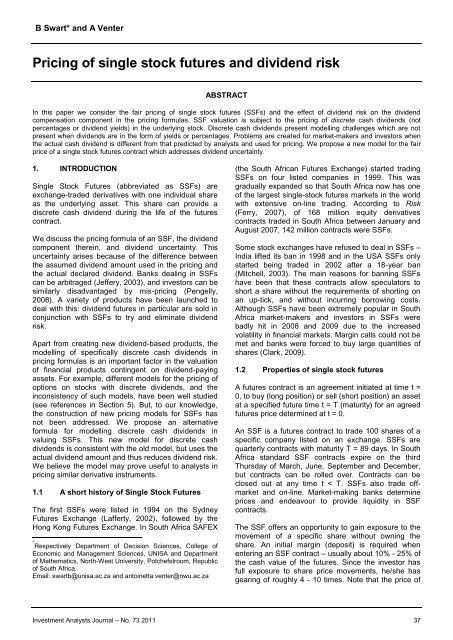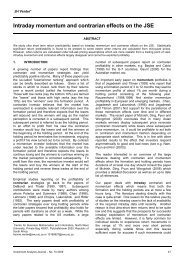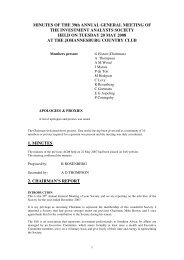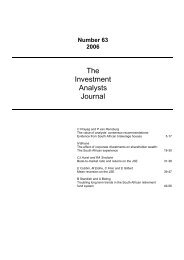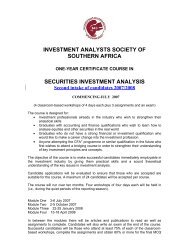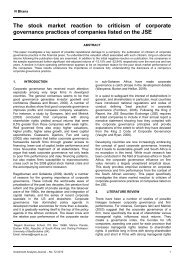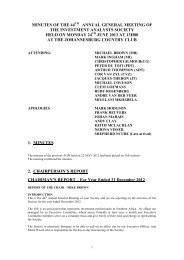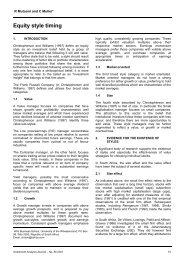Pricing of single stock futures and dividend risk - Investment ...
Pricing of single stock futures and dividend risk - Investment ...
Pricing of single stock futures and dividend risk - Investment ...
You also want an ePaper? Increase the reach of your titles
YUMPU automatically turns print PDFs into web optimized ePapers that Google loves.
<strong>Pricing</strong> B Swart* <strong>of</strong> <strong>single</strong> <strong>and</strong> A <strong>stock</strong> Venter <strong>futures</strong> <strong>and</strong> <strong>dividend</strong> <strong>risk</strong><br />
<strong>Pricing</strong> <strong>of</strong> <strong>single</strong> <strong>stock</strong> <strong>futures</strong> <strong>and</strong> <strong>dividend</strong> <strong>risk</strong><br />
ABSTRACT<br />
In this paper we consider the fair pricing <strong>of</strong> <strong>single</strong> <strong>stock</strong> <strong>futures</strong> (SSFs) <strong>and</strong> the effect <strong>of</strong> <strong>dividend</strong> <strong>risk</strong> on the <strong>dividend</strong><br />
compensation component in the pricing formulas. SSF valuation is subject to the pricing <strong>of</strong> discrete cash <strong>dividend</strong>s (not<br />
percentages or <strong>dividend</strong> yields) in the underlying <strong>stock</strong>. Discrete cash <strong>dividend</strong>s present modelling challenges which are not<br />
present when <strong>dividend</strong>s are in the form <strong>of</strong> yields or percentages. Problems are created for market-makers <strong>and</strong> investors when<br />
the actual cash <strong>dividend</strong> is different from that predicted by analysts <strong>and</strong> used for pricing. We propose a new model for the fair<br />
price <strong>of</strong> a <strong>single</strong> <strong>stock</strong> <strong>futures</strong> contract which addresses <strong>dividend</strong> uncertainty.<br />
1. INTRODUCTION *<br />
Single Stock Futures (abbreviated as SSFs) are<br />
exchange-traded derivatives with one individual share<br />
as the underlying asset. This share can provide a<br />
discrete cash <strong>dividend</strong> during the life <strong>of</strong> the <strong>futures</strong><br />
contract.<br />
We discuss the pricing formula <strong>of</strong> an SSF, the <strong>dividend</strong><br />
component therein, <strong>and</strong> <strong>dividend</strong> uncertainty. This<br />
uncertainty arises because <strong>of</strong> the difference between<br />
the assumed <strong>dividend</strong> amount used in the pricing <strong>and</strong><br />
the actual declared <strong>dividend</strong>. Banks dealing in SSFs<br />
can be arbitraged (Jeffery, 2003), <strong>and</strong> investors can be<br />
similarly disadvantaged by mis-pricing (Pengelly,<br />
2008). A variety <strong>of</strong> products have been launched to<br />
deal with this: <strong>dividend</strong> <strong>futures</strong> in particular are sold in<br />
conjunction with SSFs to try <strong>and</strong> eliminate <strong>dividend</strong><br />
<strong>risk</strong>.<br />
Apart from creating new <strong>dividend</strong>-based products, the<br />
modelling <strong>of</strong> specifically discrete cash <strong>dividend</strong>s in<br />
pricing formulas is an important factor in the valuation<br />
<strong>of</strong> financial products contingent on <strong>dividend</strong>-paying<br />
assets. For example, different models for the pricing <strong>of</strong><br />
options on <strong>stock</strong>s with discrete <strong>dividend</strong>s, <strong>and</strong> the<br />
inconsistency <strong>of</strong> such models, have been well studied<br />
(see references in Section 5). But, to our knowledge,<br />
the construction <strong>of</strong> new pricing models for SSFs has<br />
not been addressed. We propose an alternative<br />
formula for modelling discrete cash <strong>dividend</strong>s in<br />
valuing SSFs. This new model for discrete cash<br />
<strong>dividend</strong>s is consistent with the old model, but uses the<br />
actual <strong>dividend</strong> amount <strong>and</strong> thus reduces <strong>dividend</strong> <strong>risk</strong>.<br />
We believe the model may prove useful to analysts in<br />
pricing similar derivative instruments.<br />
1.1 A short history <strong>of</strong> Single Stock Futures<br />
The first SSFs were listed in 1994 on the Sydney<br />
Futures Exchange (Lafferty, 2002), followed by the<br />
Hong Kong Futures Exchange. In South Africa SAFEX<br />
* Respectively Department <strong>of</strong> Decision Sciences, College <strong>of</strong><br />
Economic <strong>and</strong> Management Sciences, UNISA <strong>and</strong> Department<br />
<strong>of</strong> Mathematics, North-West University, Potchefstroom, Republic<br />
<strong>of</strong> South Africa.<br />
Email: swartb@unisa.ac.za <strong>and</strong> antoinetta.venter@nwu.ac.za<br />
(the South African Futures Exchange) started trading<br />
SSFs on four listed companies in 1999. This was<br />
gradually exp<strong>and</strong>ed so that South Africa now has one<br />
<strong>of</strong> the largest <strong>single</strong>-<strong>stock</strong> <strong>futures</strong> markets in the world<br />
with extensive on-line trading. According to Risk<br />
(Ferry, 2007), <strong>of</strong> 168 million equity derivatives<br />
contracts traded in South Africa between January <strong>and</strong><br />
August 2007, 142 million contracts were SSFs.<br />
Some <strong>stock</strong> exchanges have refused to deal in SSFs –<br />
India lifted its ban in 1998 <strong>and</strong> in the USA SSFs only<br />
started being traded in 2002 after a 18-year ban<br />
(Mitchell, 2003). The main reasons for banning SSFs<br />
have been that these contracts allow speculators to<br />
short a share without the requirements <strong>of</strong> shorting on<br />
an up-tick, <strong>and</strong> without incurring borrowing costs.<br />
Although SSFs have been extremely popular in South<br />
Africa market-makers <strong>and</strong> investors in SSFs were<br />
badly hit in 2008 <strong>and</strong> 2009 due to the increased<br />
volatility in financial markets. Margin calls could not be<br />
met <strong>and</strong> banks were forced to buy large quantities <strong>of</strong><br />
shares (Clark, 2009).<br />
1.2 Properties <strong>of</strong> <strong>single</strong> <strong>stock</strong> <strong>futures</strong><br />
A <strong>futures</strong> contract is an agreement initiated at time t =<br />
0, to buy (long position) or sell (short position) an asset<br />
at a specified future time t = T (maturity) for an agreed<br />
<strong>futures</strong> price determined at t = 0.<br />
An SSF is a <strong>futures</strong> contract to trade 100 shares <strong>of</strong> a<br />
specific company listed on an exchange. SSFs are<br />
quarterly contracts with maturity T = 89 days. In South<br />
Africa st<strong>and</strong>ard SSF contracts expire on the third<br />
Thursday <strong>of</strong> March, June, September <strong>and</strong> December,<br />
but contracts can be rolled over. Contracts can be<br />
closed out at any time t < T. SSFs also trade <strong>of</strong>fmarket<br />
<strong>and</strong> on-line. Market-making banks determine<br />
prices <strong>and</strong> endeavour to provide liquidity in SSF<br />
contracts.<br />
The SSF <strong>of</strong>fers an opportunity to gain exposure to the<br />
movement <strong>of</strong> a specific share without owning the<br />
share. An initial margin (deposit) is required when<br />
entering an SSF contract – usually about 10% - 25% <strong>of</strong><br />
the cash value <strong>of</strong> the <strong>futures</strong>. Since the investor has<br />
full exposure to share price movements, he/she has<br />
gearing <strong>of</strong> roughly 4 - 10 times. Note that the price <strong>of</strong><br />
<strong>Investment</strong> Analysts Journal – No. 73 2011 37
<strong>Pricing</strong> <strong>of</strong> <strong>single</strong> <strong>stock</strong> <strong>futures</strong> <strong>and</strong> <strong>dividend</strong> <strong>risk</strong><br />
the <strong>futures</strong> contract is not paid at time t = 0; only the<br />
initial margin is deposited.<br />
Contracts are marked to market or marked to model.<br />
At the end <strong>of</strong> each day the daily loss or pr<strong>of</strong>it is<br />
calculated for each position <strong>and</strong> the two parties' margin<br />
accounts are adjusted. In effect the contract is closed<br />
out <strong>and</strong> rewritten every day. A maintenance margin,<br />
approximately 75% <strong>of</strong> the initial margin, is set. If the<br />
amount in either the buyer’s or the seller's margin<br />
account becomes less than this maintenance margin,<br />
a margin call is made <strong>and</strong> extra funds have to be<br />
deposited by the affected party before noon the<br />
following day. Failure to make the margin call implies<br />
that the broker will close out the position.<br />
2. PRICING FORMULAS FOR FUTURES<br />
We present the development <strong>of</strong> the theoretical pricing<br />
formulas, with emphasis on the <strong>dividend</strong> component. It<br />
is important to note the properties <strong>of</strong> the basic pricing<br />
formulas in order to verify our proposed new model.<br />
This section may also serve to clarify formulas<br />
published by brokers <strong>and</strong> banks that do not always<br />
explain the <strong>dividend</strong> component in detail.<br />
2.1 The basic continuous model for fair pricing<br />
Let S(.) be the value <strong>of</strong> a non-<strong>dividend</strong> paying share. A<br />
<strong>futures</strong> contract on S initiated at t = 0, with time <strong>of</strong><br />
delivery T, is a financial instrument such that at every<br />
time t, 0 ≤ t ≤ T, there exists in the market a quoted<br />
<strong>futures</strong> price F(t;T;S) for underlying S, determined at t,<br />
for delivery at T. In particular:<br />
a. There is a payment stream (corresponding to<br />
daily mark-to-market) so that in each interval (t,<br />
t+1] the holder receives the amount F(t +1;T;S) −<br />
F(t;T;S).<br />
b. F(T;T;S) = S(T).<br />
Let r denote the (constant) <strong>risk</strong>-free rate. The fair, noarbitrage<br />
theoretical <strong>futures</strong> price, excluding<br />
transaction costs, is ( Björk, 2004):<br />
F(t;T;S) = S(t)e r (T−t) . … (1)<br />
Note: The payment stream in point (a) above reflects<br />
daily margin adjustments in the mark-to-market<br />
process. In total the value <strong>of</strong> the stream over [0,T] is:<br />
T<br />
t0<br />
[F(t+1;T;S) − F(t;T;S)] = S(T) F(0;T;S) … (2)<br />
This is an extremely important property: at time T you<br />
will have paid the <strong>futures</strong> price F(0;T;S) which was<br />
agreed upon at time 0, <strong>and</strong> will have “received an<br />
asset” worth S(T). “Receiving the asset” does not<br />
necessarily imply receiving the physical underlying –<br />
through the payment stream the holder <strong>and</strong> writer have<br />
in fact fulfilled all contractual obligations.<br />
2.2 Dividends <strong>and</strong> continuous pricing models<br />
We now consider shares which pay <strong>dividend</strong>s.<br />
Dividends are typically paid out quarterly or semiannually.<br />
The effect <strong>of</strong> the payment is a drop in share<br />
price as the share goes ex-<strong>dividend</strong>. This drop is<br />
assumed to be <strong>of</strong> the same size as the <strong>dividend</strong><br />
payment. The holder <strong>of</strong> the SSF does not receive the<br />
<strong>dividend</strong> but is subjected to the drop in share price.<br />
There must therefore be compensation <strong>and</strong> this forms<br />
the crucial component <strong>of</strong> the pricing formula. The<br />
continuous <strong>futures</strong> price on assets paying an income<br />
will be denoted by F D (t;T;S) where S now denotes the<br />
price <strong>of</strong> the <strong>dividend</strong>-paying <strong>stock</strong>.<br />
Dividends are <strong>of</strong>ten modelled as continuous yields or<br />
percentages <strong>of</strong> <strong>stock</strong> price S. These provide the<br />
simplest analysis, but cannot be applied to SSFs<br />
where there is a <strong>single</strong> discrete cash <strong>dividend</strong> paid at t<br />
= d. The usual way <strong>of</strong> dealing with the discrete cash<br />
<strong>dividend</strong> (to effect compensation) is to deduct the<br />
present value <strong>of</strong> the <strong>dividend</strong> from the share price at<br />
times t < d <strong>and</strong> to apply the pricing formula (2.1) to the<br />
resulting capital process. Consider a discrete cash<br />
<strong>dividend</strong> with forecast value D to be paid at time d.<br />
From Jarrow <strong>and</strong> Turnbull (1995) we have the<br />
continuous-time SSF pricing formula:<br />
rTt<br />
r(d t)<br />
e [St – e D]<br />
D <br />
F t;T;S for 0 t d T<br />
rTt<br />
<br />
e St<br />
for d t T.<br />
… (3)<br />
2.3 Discrete fair pricing model with <strong>dividend</strong>s<br />
The pricing formulas that are used in practise are<br />
discrete. We denote the discrete version <strong>of</strong> the <strong>futures</strong><br />
price in Equation (3) by SSF(t). Then<br />
<br />
S t [1 r (T t) – D 1 r (T d)]<br />
<br />
SSFt<br />
for 0 t d T<br />
<br />
<br />
St [1 r (T t)] for d t T.<br />
… (4)<br />
Formula (4) gives a fair theoretical price (excluding<br />
transactions costs) <strong>of</strong> an SSF. Times are annualised.<br />
The formula satisfies SSF(T) = S(T). The equivalent<br />
form <strong>of</strong> the important property (Equation (2)) is that the<br />
value <strong>of</strong> the payment stream over [0,T] equals:<br />
T<br />
t0<br />
[SSF(t+1) − SSF(t)]<br />
= SSF(T) SSF(0)<br />
= {S(T) + D[1 + r (T d)]}<br />
S(0)[1 + r T]. … (5)<br />
38 <strong>Investment</strong> Analysts Journal – No. 73 2011
<strong>Pricing</strong> <strong>of</strong> <strong>single</strong> <strong>stock</strong> <strong>futures</strong> <strong>and</strong> <strong>dividend</strong> <strong>risk</strong><br />
The investor will have paid S(0)[1 + rT] <strong>and</strong> received<br />
amount {S(T) + D[1 + r(T d)]}. Thus, although<br />
investors do not receive the <strong>dividend</strong> as such at time d,<br />
they are compensated since at time T they will have<br />
received the future value <strong>of</strong> amount D via the mark-tomarket<br />
payment stream.<br />
3. DIVIDEND RISK<br />
The first problem in the pricing <strong>of</strong> SSFs is the fact that<br />
the <strong>dividend</strong> amount D, used to establish the SSF<br />
price at time t = 0, is a forecast based on analysts’<br />
consensus <strong>and</strong> historical data. It is not necessarily the<br />
actual amount <strong>of</strong> the <strong>dividend</strong> that will be declared <strong>and</strong><br />
paid. This introduces <strong>dividend</strong> <strong>risk</strong>. If the forecast <strong>and</strong><br />
actual <strong>dividend</strong>s differ brokers have to approach<br />
market-makers to adjust the <strong>dividend</strong> component <strong>and</strong><br />
to re-price the SSF − a time-consuming process<br />
(Ferry, 2007; Jeffery, 2003; Pengelly, 2008). The<br />
actual time d when the <strong>dividend</strong> will be paid is similarly<br />
uncertain at time 0.<br />
A second problem is that the forecast amount D may<br />
differ between institutions <strong>and</strong>, for some institutions,<br />
lead to the <strong>risk</strong> <strong>of</strong> being arbitraged (Ferry, 2007). It<br />
also appears (Jeffery, 2003) that unrealistically high<br />
<strong>dividend</strong> yields could be applied deliberately to lower<br />
prices <strong>of</strong> structured products (the higher the value <strong>of</strong><br />
D, the lower the price SSF(0)). In other words,<br />
deliberate mis-pricing can be used to buy market<br />
share.<br />
Dividends present many other challenges to pricing.<br />
Some studies (for example, Bhana, 1991; Docking <strong>and</strong><br />
Koch, 2005) find that, although at ex-<strong>dividend</strong> date d<br />
the <strong>stock</strong> price is adjusted by amount D in theory,<br />
prices <strong>of</strong>ten drop by only 50% - 90% <strong>of</strong> D <strong>and</strong> the drop<br />
is usually not observed on the ex-<strong>dividend</strong> date unless<br />
D is particularly large. Furthermore, (Haug, 2003),<br />
cash <strong>dividend</strong>s tend to be smaller (alternatively larger)<br />
than expected after significant drops (or increases) in<br />
share price. Tax implications due to the magnitude <strong>of</strong><br />
D also affect the drop in share price. We will not<br />
address these issues in our analysis.<br />
The following two sections provide examples<br />
illustrating the effect <strong>of</strong> <strong>dividend</strong> <strong>risk</strong> <strong>and</strong> uncertainty on<br />
the pricing <strong>of</strong> SSFs.<br />
3.1 Example: Two contracts using different<br />
forecast <strong>dividend</strong>s<br />
Consider the following scenario. We have two<br />
contracts on share S that differ only in the value <strong>of</strong><br />
forecast <strong>dividend</strong> D.<br />
Time <strong>of</strong> pricing t = 20 June 2009.<br />
Both SSFs on share S expire on T = 17 September<br />
2009.<br />
S(t) = R80,20 = spot price <strong>of</strong> S on 20 June<br />
S(t + 1) = R72,18 = spot price <strong>of</strong> S on 21 June<br />
r = 12% p.a.<br />
Contract 1: D = R5,00 (the forecast <strong>dividend</strong>)<br />
Contract 2: D* = R3,00 (alternative forecast <strong>dividend</strong>)<br />
Expected <strong>dividend</strong> date d = 30 June 2009.<br />
Then, using Formula 4, we can construct Table 1:<br />
Table 1: Effect <strong>of</strong> different <strong>dividend</strong>s <strong>and</strong> share price movement on SSFs<br />
Initial price<br />
(t = 0)<br />
Initial margin<br />
(20%)<br />
Price at t =1<br />
after 10% drop in S<br />
Change in<br />
margin account<br />
Percentage change in<br />
margin account<br />
Share S 80,20 n/a 72,18 n/a n/a<br />
Contract 1 #<br />
7 742,00 1 548,40 6 914,00 −828 −53,47%<br />
D = 5,00<br />
Contract 2 #<br />
7 947,00 1 589,40 7 119,00 −828 −52,09%<br />
D* = 3,00<br />
#<br />
Contracts on 100 shares<br />
Discussion <strong>of</strong> results in Table 1<br />
There is a 2,65% difference in the initial prices <strong>and</strong><br />
initial margins <strong>of</strong> the two SSF contracts. After a 10%<br />
decrease in share price S over 1 day, both contracts<br />
experience the same absolute value drop in margin<br />
account <strong>and</strong> will attract a margin call. However, for<br />
Contract 1 (high <strong>dividend</strong> forecast) the percentage<br />
drop in the margin account is higher than for Contract<br />
2 (lower <strong>dividend</strong> forecast). Therefore although buyers<br />
<strong>of</strong> Contract 1 initially paid a lower margin, they are<br />
relatively harder hit than buyers <strong>of</strong> Contract 2 by a<br />
percentage-wise higher margin call.<br />
3.2 Example: A change in <strong>dividend</strong> amount<br />
during the life <strong>of</strong> one contract<br />
Consider a decrease <strong>of</strong> 10% in the initial time t = 0<br />
forecast value D so that the actual declared <strong>dividend</strong><br />
paid at time t = d is D dec = 0,9D.<br />
<strong>Investment</strong> Analysts Journal – No. 73 2011 39
<strong>Pricing</strong> <strong>of</strong> <strong>single</strong> <strong>stock</strong> <strong>futures</strong> <strong>and</strong> <strong>dividend</strong> <strong>risk</strong><br />
Assume that r = 0,10; <strong>and</strong> (T d) = 20/365. The<br />
change is announced at time t < d. At that time the<br />
price must therefore change from<br />
SSF(t) = S(t)[1 + r(T – t)] – D[1 + r(T – d)]<br />
to<br />
SSF(t) = S(t)[1 + r(T – t)] – 0,9D[1 + r(T – d)].<br />
The (almost instantaneous) change in theoretical value<br />
<strong>of</strong> the SSF price is:<br />
0,1D[1 + 0,1 (20/365)] = 0,101D. This is a 10,1%<br />
change in the <strong>futures</strong> price <strong>and</strong> re-pricing will have to<br />
take place.<br />
4. DEALING WITH DIVIDEND RISK –<br />
DIVIDEND FUTURES<br />
Dividends in general can themselves be traded in<br />
various ways, for example with products such as<br />
contracts for difference <strong>and</strong> <strong>dividend</strong> swaps.<br />
Specifically in the case <strong>of</strong> SSFs there has been<br />
considerable dem<strong>and</strong> for tools to manage <strong>dividend</strong><br />
uncertainty. One tool is obviously to create products<br />
that can be used to hedge <strong>dividend</strong> <strong>risk</strong>. The <strong>dividend</strong><br />
<strong>futures</strong> contract is such a product.<br />
The <strong>dividend</strong> future (DIVF) is a derivative contract that<br />
can be used to hedge against the <strong>dividend</strong> <strong>risk</strong> that<br />
accompanies trade in SSFs. The DIVF contract is<br />
booked in conjunction with an SSF. Basically the<br />
combination becomes an SSF on a <strong>stock</strong> without<br />
<strong>dividend</strong>s where the actual <strong>dividend</strong> amount is then<br />
exchanged. The investor is compensated in this way<br />
for the drop in share price. The price <strong>of</strong> the SSF on a<br />
non-<strong>dividend</strong> paying <strong>stock</strong> is <strong>of</strong> course simply SSF(t) =<br />
S(t)[1 + r(T – t)]. Dividends do not have to be<br />
predicted, they are simply exchanged <strong>and</strong> <strong>dividend</strong> <strong>risk</strong><br />
is eliminated.<br />
There is no doubt as to the importance <strong>of</strong> the DIVF<br />
market as a tool to manage <strong>dividend</strong> <strong>risk</strong>. One<br />
“disadvantage” for investors in SSFs may be that they<br />
are in effect obliged to enter into an additional contract<br />
to hedge <strong>dividend</strong> uncertainty. Another potential<br />
problem is that the <strong>dividend</strong> <strong>futures</strong> market is not<br />
always very liquid. Eurostoxx 50 <strong>dividend</strong> <strong>futures</strong> saw<br />
a collapse in May 2010 (Cameron <strong>and</strong> Wood, 2010).<br />
An illiquid DIVF market means investors may have<br />
difficulty in using <strong>dividend</strong> <strong>futures</strong> as hedging<br />
instrument.<br />
Another way <strong>of</strong> addressing <strong>dividend</strong> <strong>risk</strong> in SSFs would<br />
be to improve the modelling <strong>of</strong> the discrete <strong>dividend</strong><br />
component in the pricing <strong>of</strong> the SSF.<br />
5. DIVIDEND MODELLING: A NEW MODEL<br />
FOR ESTABLISHING THE FAIR PRICE OF<br />
AN SSF<br />
The modelling <strong>of</strong> discrete cash <strong>dividend</strong>s is one <strong>of</strong> the<br />
big challenges in pricing equity derivative products: the<br />
modelling must address the need for compensation<br />
due to the drop in the underlying share price when the<br />
<strong>dividend</strong> is paid. In the case <strong>of</strong> the pricing <strong>of</strong> options on<br />
shares with discrete <strong>dividend</strong>s, a variety <strong>of</strong> different<br />
pricing models have been developed. See Musiela <strong>and</strong><br />
Rutkowski, 1997; Bos <strong>and</strong> V<strong>and</strong>ermark, 2002; Bos,<br />
Gairat <strong>and</strong> Shepeleva, 2003; Frischling, 2002; Haug et<br />
al., 2003; Vellekoop <strong>and</strong> Nieuwenhuis, 2006.<br />
In SSF pricing however, all available evidence shows<br />
that discrete <strong>dividend</strong>s have always been dealt with<br />
(as shown in Section 2.2) by introducing the “reduced”<br />
capital process [S(t) – e −r(d− t) D] for times t < d. That is,<br />
the present value <strong>of</strong> the forecast <strong>dividend</strong> is deducted<br />
from the share price S at t < d so that compensation<br />
takes place before the <strong>dividend</strong> is paid.<br />
We suggest that the SSF pricing formula can be<br />
modified by developing a new model for discrete<br />
<strong>dividend</strong>s. The new model introduces an “augmented”<br />
capital process that uses the future value <strong>of</strong> the actual<br />
declared <strong>dividend</strong> amount for compensation at times<br />
t > d.<br />
As a first step we distinguish between assumed<br />
<strong>dividend</strong> D <strong>and</strong> actual declared <strong>dividend</strong> D dec . We then<br />
propose a pricing model which is based on the actual<br />
<strong>dividend</strong> date d <strong>and</strong> amount D dec . Let S denote the<br />
usual <strong>stock</strong> price process <strong>and</strong> let S* be the process<br />
defined by<br />
<br />
<br />
r(td)<br />
S t for 0 t d<br />
<br />
S * t<br />
S t Ddece<br />
<br />
for t d.<br />
<br />
… (6)<br />
The <strong>dividend</strong> component in S*at t > d contains the<br />
future value <strong>of</strong> the actual declared <strong>dividend</strong> <strong>and</strong> is<br />
added to S(t) to compensate for the drop in share price<br />
at t = d. Process S* can be seen as an equivalent<br />
“augmented” or “<strong>dividend</strong>-compensated” process for S.<br />
The continuous-time <strong>futures</strong> price formula for S*(t) is<br />
then: F(t, T, S*) = S*(t) e r (T t) . Using Equation (6) we<br />
get the new <strong>futures</strong> pricing formula F* in terms <strong>of</strong> S:<br />
<br />
<br />
<br />
r(Tt)<br />
<br />
S t e for 0 t d<br />
r(Tt) r(Td)<br />
F * t, S<br />
S t e Ddece<br />
<br />
fort d.<br />
<br />
… (7)<br />
40 <strong>Investment</strong> Analysts Journal – No. 73 2011
<strong>Pricing</strong> <strong>of</strong> <strong>single</strong> <strong>stock</strong> <strong>futures</strong> <strong>and</strong> <strong>dividend</strong> <strong>risk</strong><br />
We now use Formula (7) to propose the following<br />
discrete-form fair pricing formula for an SSF on a <strong>stock</strong><br />
S that pays a <strong>single</strong> cash <strong>dividend</strong> during the life <strong>of</strong> the<br />
contract:<br />
<br />
S t [1 r (T t)]<br />
<br />
for 0 t d<br />
SSF * t<br />
<br />
… (8)<br />
St [1 r (T t) Ddec1 r (T d)]<br />
<br />
for d t T.<br />
At time t = 0 the value <strong>of</strong> the contract is now SSF*(0) =<br />
S(0) [1 + r T]. This determines the initial margin. The<br />
<strong>dividend</strong> compensation factor only enters the valuation<br />
from time t = d when the share price drops. This<br />
means that we are able to use the actual declared<br />
<strong>dividend</strong> amount <strong>and</strong> <strong>dividend</strong> date at that stage.<br />
It is essential to verify that the cash-flow property in<br />
Equation (5) also holds for new formula SSF*. In fact:<br />
SSF*(T) SSF*(0) =<br />
S(T) + D dec [1 + r (T d)] − S(0)[1 + r T] … (9)<br />
We thus see that in both the old <strong>and</strong> new models the<br />
total cash-flow over [0, T] implies that, at time T, the<br />
investor will have paid the agreed <strong>futures</strong> price S(0)[1<br />
+ r T] <strong>and</strong> will have received the value S(T) plus the<br />
future value <strong>of</strong> a <strong>dividend</strong>. The two models are<br />
consistent in this sense.<br />
The big difference between models (4) <strong>and</strong> (8) is that<br />
our new model uses the actual <strong>dividend</strong> D dec at times t<br />
≥ d <strong>and</strong> eliminates the <strong>dividend</strong> <strong>risk</strong> <strong>and</strong> re-pricing <strong>risk</strong><br />
that arises from the use <strong>of</strong> forecast value D at time t <<br />
d as in the old model. See Example 5.1 below.<br />
Of course SSFs priced by Formula (4) have a lower<br />
initial value than those priced by (8). The initial margin<br />
will thus be lower. This may at first seem<br />
advantageous to buyers, but in fact the higher initial<br />
margin <strong>of</strong> the new model reduces the negative effects<br />
<strong>of</strong> price decreases. Example 5.2 illustrates this.<br />
Finally, the possibility <strong>of</strong> manipulating <strong>dividend</strong><br />
estimations is also eliminated in the new model.<br />
5.1 Example: Comparison <strong>of</strong> values for old <strong>and</strong><br />
new models at t = 0 <strong>and</strong> t = d<br />
We compare the prices <strong>of</strong> the SSF contract for the<br />
data given in Section 3, Example 3.1. Assume the<br />
expected <strong>and</strong> actual <strong>dividend</strong> date is d = 30 June<br />
2009; <strong>and</strong> that the assumed <strong>dividend</strong> is D = R5,00;<br />
with actual <strong>dividend</strong> D dec = R3,00.<br />
t = 0 = 20 June.<br />
Formula (4) (old model):<br />
SSF(0) = 77,42<br />
Formula (8) (new model):<br />
SSF*(0) = 80,20[1 + 0,12(89)/365] + 0<br />
= 82,55.<br />
For simplicity we assume the <strong>stock</strong> price remains at<br />
S(t) = 80,20 up to the ex-<strong>dividend</strong> date. At time t 1 = 29<br />
June:<br />
Formula (4):<br />
SSF(t 1 ) = 80,20[1+0,12(80)/365]–5,00[1+0,12(79)/365]<br />
= 77,18<br />
Formula (8):<br />
SSF*(t 1 ) = 80,20 [1 + 0,12(80)/365] + 0 = 82,31<br />
Note that the change in <strong>futures</strong> price over period 20-29<br />
June is exactly the same amount (0,24) for each<br />
formula, as it should be.<br />
At time t 2 = 1 July, even though Model (4) presumed<br />
S(t 2 ) = 80,20 – 5 = 75,20, the observed <strong>stock</strong> price will<br />
be S(t 2 ) = 80,20 – 3 = 77,20. So at t 2 = 1 July:<br />
Formula (4):<br />
SSF(t 2 ) = 77,20 [1 + 0,12(78)/365] – 0 = 79,17.<br />
Formula (8):<br />
SSF*(t 2 )= 77,20[1+0,12(78)/365]+3,00[1+0,12(79)/365]<br />
= 82,26.<br />
Note: The change in <strong>futures</strong> prices from 29 June to 1<br />
July across <strong>dividend</strong> date d = 30 June differs<br />
substantially for the two pricing models. It is 1,99 (or<br />
R199 per contract) for the old model <strong>and</strong> only 0,05 (or<br />
R5 per contract) for the new model. This is a big<br />
difference <strong>and</strong> highlights the <strong>dividend</strong> <strong>risk</strong>. With the old<br />
model <strong>of</strong> Formula (4) re-pricing would have been<br />
called for.<br />
5.2 Example: Comparison <strong>of</strong> initial margins<br />
<strong>and</strong> changes in margin accounts<br />
The data <strong>of</strong> Examples 3.1 <strong>and</strong> 5.1 are used.<br />
Value <strong>of</strong> contract (100 shares) for old pricing model:<br />
SSF(0) = 7 742,00.<br />
Value <strong>of</strong> contract (100 shares) for new pricing model:<br />
SSF*(0) = 8 255,00.<br />
Initial margin <strong>of</strong> 20% for old model: 1 548,40<br />
Initial margin <strong>of</strong> 20% for new model: 1 651,00<br />
Consider a drop <strong>of</strong> 10% in share price S over 1 day<br />
(20 June – 21 June).<br />
Change in margin account for old model: −828,00<br />
Percentage change in margin account for old model:<br />
−53,47%<br />
<strong>Investment</strong> Analysts Journal – No. 73 2011 41
<strong>Pricing</strong> <strong>of</strong> <strong>single</strong> <strong>stock</strong> <strong>futures</strong> <strong>and</strong> <strong>dividend</strong> <strong>risk</strong><br />
Change in margin account for new model: −828,00<br />
Percentage change in margin account for new model:<br />
−50,15%<br />
Note: The higher initial price <strong>and</strong> initial margin with the<br />
new model has the effect <strong>of</strong> smaller percentage<br />
changes in the margin account than with the old<br />
model.<br />
6. CONCLUSION<br />
Classic pricing formulas for SSFs use assumed <strong>and</strong><br />
not actual <strong>dividend</strong>s. The st<strong>and</strong>ard (old) pricing models<br />
namely deduct the present value <strong>of</strong> the forecast<br />
<strong>dividend</strong> from the future <strong>stock</strong> price before the <strong>dividend</strong><br />
date. The problem is that forecast values may differ<br />
between institutions <strong>and</strong> also differ from the actual<br />
declared <strong>dividend</strong>. This means the <strong>futures</strong> contracts<br />
are subject to <strong>dividend</strong> uncertainty. Our examples<br />
illustrate the complications in pricing that may arise<br />
with a resulting need for re-pricing the SSF.<br />
Although <strong>dividend</strong> <strong>futures</strong> can be traded together with<br />
SSFs to manage <strong>dividend</strong> <strong>risk</strong>, it is important also to<br />
investigate the fundamental modelling <strong>of</strong> discrete<br />
<strong>dividend</strong>s. We suggest a new model for pricing SSFs<br />
that is consistent with the old model, but that takes the<br />
actual declared <strong>dividend</strong> into consideration. Investors<br />
are compensated after the <strong>dividend</strong> date by adding the<br />
future value <strong>of</strong> the actual <strong>dividend</strong> to the future <strong>stock</strong><br />
price. Dividend <strong>risk</strong> <strong>and</strong> re-pricing are minimised in this<br />
way. The higher initial margin (due to the higher price)<br />
for the new pricing model also has the effect <strong>of</strong> smaller<br />
percentage changes in the margin account.<br />
We believe that this model for discrete <strong>dividend</strong>s in<br />
SSFs may provide analysts with fresh applications in<br />
other <strong>futures</strong> <strong>and</strong> forward based products.<br />
ACKNOWLEDGEMENT<br />
We would like to thank Pr<strong>of</strong> Colin Firer for his<br />
suggestions.<br />
REFERENCES<br />
Cameron M <strong>and</strong> Wood D. 2010. Dividend rout blamed<br />
on hedge fund short positions. Risk, December: 10.<br />
Clark J. 2009. Fin24 Special report, 2 August.<br />
Ferry J. 2007. An unusual existence. Risk Special<br />
Report, October: 77-79.<br />
Docking D <strong>and</strong> Koch P. 2005. Sensitivity <strong>of</strong> investor<br />
reaction to market direction <strong>and</strong> volatility: <strong>dividend</strong><br />
change announcements. Journal <strong>of</strong> Financial<br />
Research, 28(1): 21-40.<br />
Frischling V. 2002. A discrete question. Risk, January:<br />
115-116.<br />
Haug EG, Haug J <strong>and</strong> Lewis A. 2003. Back to basics:<br />
A new approach to the discrete <strong>dividend</strong> problem.<br />
www.math.ku.dk.<br />
Hull JC. 2009. Futures, options <strong>and</strong> other derivatives:<br />
Pearson Editions.<br />
Jarrow R <strong>and</strong> Turnbull S. 1996. Derivative securities:<br />
International Thomson Publishing Company.<br />
Jeffery C. 2003. The <strong>dividend</strong> divide. Risk, August:16-<br />
18.<br />
Lafferty P. 2002. Single <strong>stock</strong> <strong>futures</strong>: McGraw-Hill.<br />
Mitchell K. 2003. Single <strong>stock</strong> <strong>futures</strong>, an investor’s<br />
guide: John Wiley & Sons.<br />
Musiela M <strong>and</strong> Rutkowski M. 1997. Martingale<br />
methods in financial modelling: Springer.<br />
Pengelly M. 2008. Gambling on <strong>dividend</strong>s. Risk,<br />
December: 21-23.<br />
Vellekoop MH <strong>and</strong> Nieuwenhuis JW. 2006. Efficient<br />
pricing <strong>of</strong> derivatives on assets with discrete <strong>dividend</strong>s.<br />
Applied Mathematical Finance, 13(3): 265-284.<br />
Wilmott P, Howson S <strong>and</strong> Dewynne J. 1995. The<br />
mathematics <strong>of</strong> financial derivatives: Cambridge<br />
University Press.<br />
Bhana N. 1991. Reaction <strong>of</strong> Johannesburg Stock<br />
Exchange to major shifts in <strong>dividend</strong> policy. South<br />
African Journal <strong>of</strong> Business Management , 22(3):33-<br />
49.<br />
Bos M <strong>and</strong> V<strong>and</strong>ermark S. 2002. Finessing fixed<br />
<strong>dividend</strong>s. Risk, September: 157-158.<br />
Bos R, Gairat A <strong>and</strong> Shepeleva A. 2003. Dealing with<br />
discrete <strong>dividend</strong>s. Risk, January: 109-112.<br />
Björk T. 2004. Arbitrage theory in continuous time:<br />
Oxford University Press.<br />
42 <strong>Investment</strong> Analysts Journal – No. 73 2011


